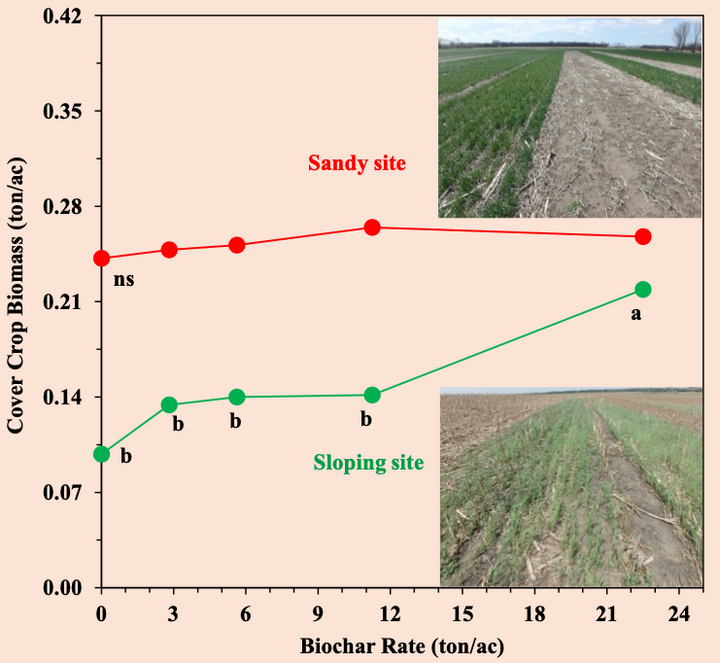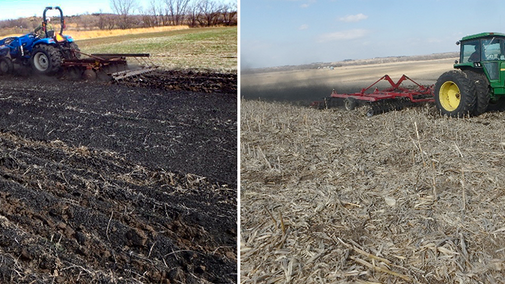Does applying biochar improve the health of soils and crop yields? This is a question that some may ask when they hear about biochar. There are little data from long-term and well-designed field experiments to answer this question. The few field studies in temperate regions show limited or mixed effects of biochar on soils and crop yields. In contrast, biochar has been shown to improve soils and crop yields in subtropical and tropical regions.
Often, biochar benefits observed in other regions (subtropical and tropical regions) are extended by popular media to temperate soils. Biochar benefits observed elsewhere may or may not be observed in temperate soils because site-specific conditions including soil type, cropping systems, crop management, scale of farming, biochar feedstock, biochar amount applied, and biochar properties vary. More field data from temperate soils are needed to better understand the potential benefits and limitations of biochar use.
Research Questions
In 2020, we set out to answer the specific questions in Table 1. We selected three environmentally sensitive soils, including sandy, sloping and semi-arid soils across Nebraska. We hypothesized that environmentally sensitive soils could rapidly benefit from biochar. In each soil, we have been measuring soil health indicators and crop yields after wood biochar application with and without the addition of winter cover crops. This ongoing multi-site biochar project is funded by the USDA National Institute of Food and Agriculture Foundational Program.
| Background | Research Questions |
|---|---|
| 1. The few biochar studies in temperate regions were on nearly-level, fertile and highly productive soils. 2. These few studies observed small or no biochar effects on soil properties and crop yields. |
Wouldn’t biochar application to degradation-prone soils including sandy, sloping and semi-arid soils be more beneficial than in highly productive soils? |
| 1. Most studies were conducted in the greenhouse using large amounts of biochar (>20 ton/acre). 2. High biochar application rates may not be economical. |
What is the minimum amount of biochar that can be applied to croplands to observe any potential benefits on soils and crops? |
| 1. Soil and crop benefits of biochar may be small or inconsistent, depending on site-specific conditions. 2. Studies coupling biochar with other amendments are rare. |
Would combining biochar with cover crops enhance biochar performance relative to biochar alone? |
Where and How are the Experiments Being Conducted?
The ongoing experiments are being conducted at three sites with environmentally sensitive soils (sandy, sloping and semi-arid) beginning in spring 2020 (Figure 1). The sandy and sloping sites are on-farm experiments located in eastern Nebraska near Stanton and Beaver Crossing, Nebraska, while the semi-arid site is located at the University of Nebraska-Lincoln’s High Plains Agricultural Laboratory near Sidney, Nebraska. The annual mean precipitation is 29 inches for the sandy and sloping (7-11% slope) sites in eastern Nebraska, and 18 inches for the semi-arid site in western Nebraska.
The experiment is a split-plot arranged in a randomized complete block design with five wood biochar treatments (0, 2.81, 5.62, 11.25, and 22.5 ton/ac) as main plots (30 feet by 35 feet) and three cover treatments (no cover crop, winter rye, and mixture of winter rye, Austrian winter pea and radish) as split plots (15 feet by 35 feet) replicated four times. Wood biochar (83.6% carbon and 94% of particles sized between 1 to 4 mm) was acquired from High Plains Biochar after pyrolysis at 760°C.
The biochar was disked into the soil to about four inches once in spring 2020, then the experiment was managed as no-till going forward. The crop rotation is corn-soybean for the sites in eastern Nebraska, and the winter cover crops are drilled in late October after corn or soybean harvest. At the semi-arid site, we planned to have a pea-winter wheat–pea rotation, but persistent drought did not allow successful crop establishment during the three years (2020, 2021, 2022) after biochar application.
What Have We Learned After Three Years?

- Cover crops did not grow at the semi-arid site (western Nebraska) due to persistent drought. This suggests combining cover crops with biochar may not be feasible in water-limited regions, especially when precipitation is below normal.
- Cover crops established well at the sandy and sloping sites in eastern Nebraska due to higher precipitation than in the semi-arid site (Figure 2). However, cover crop biomass was relatively low and did not exceed 0.27 tons/ac. Winter cover crops drilled in fall after corn or soybean harvest do not often produce high amounts of biomass.
- The synergism between wood biochar and cover crops was not significant. The relatively low production of cover crop biomass and short experiment duration may have limited biochar-cover crop synergism.
- Soil C concentration increased, as expected, but a significant amount of C was lost during the three years likely due to C emissions, soil erosion and decomposition.
- Biochar improved some soil properties more at the sandy and sloping sites than at the semi-arid site. The highest rate of biochar application (22.5 ton/ac) improved soil sorptivity (early stages of water infiltrations) in the sandy and sloping sites in the first year, but not in the third year (Table 2).
- At the sandy site, biochar application at high rates (>11.25 ton/ac) increased soil organic matter concentration, soil pH, and available water in the first year but not in the third year (Table 2). This suggests biochar benefits in sandy soils could be short-lived.
- At the sloping site, biochar application at high rates increased organic matter concentration and microbial biomass after three years (Table 2).
- Biochar did not affect nitrate leaching potential and P concentration but increased K concentration (Table 2).
- Biochar did not increase corn and soybean yields (Table 3), but 22.5 ton/ac of biochar increased cover crop biomass production at the sloping site by 0.12 ton/ac (Figure 2).
- Cover crop biomass between single species and cover crop mixture did not differ.
| Biochar (ton/ac) |
Soil sorptivity (inch s-1/2) |
Available water (inch) |
pH | Organic matter (%) |
Nitrate (ppm) |
P (ppm) |
K (ppm) |
Microbial biomass (nmol g-1) |
|---|---|---|---|---|---|---|---|---|
| Sandy soil | ||||||||
| 0 | 0.06ns | 0.04ns | 5.07ns | 1.37ns | 7.28ns | 85.17ns | 195b | 68ns |
| 2.81 | 0.06 | 0.03 | 5.13 | 1.37 | 6.28 | 71.75 | 193b | 67 |
| 5.62 | 0.06 | 0.06 | 5.15 | 1.29 | 7.47 | 64.50 | 211ab | 67 |
| 11.25 | 0.06 | 0.07 | 5.36 | 1.54 | 8.91 | 67.17 | 240a | 81 |
| 22.5 | 0.08 | 0.05 | 5.38 | 1.53 | 10.58 | 72.42 | 236a | 73 |
| Sloping soil | ||||||||
| 0 | 0.07ns | 0.04ns | 6.62ns | 3.01c | 21.93ns | 9.00ns | 254ns | 118b |
| 2.81 | 0.07 | 0.04 | 6.83 | 3.19c | 17.73 | 12.42 | 271 | 112b |
| 5.62 | 0.08 | 0.04 | 6.67 | 3.40bc | 17.59 | 11.08 | 262 | 124ab |
| 11.25 | 0.09 | 0.03 | 6.53 | 3.99b | 18.60 | 10.50 | 244 | 121b |
| 22.5 | 0.12 | 0.04 | 6.46 | 5.01a | 19.43 | 13.42 | 266 | 139a |
| Semi-arid soil | ||||||||
| 0 | 0.03ns | 0.07ns | 6.68ns | 3.42ns | 24.80ns | 33.75ns | 858ns | 139ns |
| 2.81 | 0.04 | 0.07 | 6.80 | 3.20 | 21.10 | 32.25 | 800 | 119 |
| 5.62 | 0.04 | 0.06 | 6.88 | 3.20 | 28.70 | 46.50 | 822 | 109 |
| 11.25 | 0.04 | 0.07 | 6.73 | 3.30 | 21.13 | 40.25 | 773 | 118 |
| 22.5 | 0.04 | 0.08 | 6.98 | 3.45 | 19.25 | 41.00 | 755 | 105 |
| Site | Biochar | Crop Yield (ton/ac) | ||
|---|---|---|---|---|
| Year 1 (Corn) | Year 2 (Soybean) | Year 3 (Corn) | ||
| Sandy | 0 | 5.14±3.67ns | 0.64±0.40ns | 2.28±2.19ns |
| 2.81 | 6.44±1.94 | 0.84±0.28 | 3.06±1.50 | |
| 5.62 | 6.18±2.99 | 0.75±0.32 | 2.40±2.36 | |
| 11.25 | 6.55±0.43 | 0.78±0.30 | 2.66±2.35 | |
| 22.5 | 5.89±1.48 | 0.87±0.38 | 2.65±2.44 | |
| Year 1 (Soybean) | Year 2 (Corn) | Year 3 (Soybean) | ||
| Sloping | 0 | 0.95±0.32ns | 6.03±1.44ns | 1.62±0.90ns |
| 2.81 | 1.08±0.38 | 5.90±1.25 | 1.55±0.42 | |
| 5.62 | 1.41±0.21 | 5.70±0.93 | 1.51±0.35 | |
| 11.25 | 1.33±0.39 | 5.57±1.37 | 1.51±0.55 | |
| 22.5 | 1.61±0.47 | 6.74±1.12 | 1.82±0.76 | |
What Is the Take-home Message?
- Biochar can improve some soil properties in some soils, but large amounts of biochar (at least 11.25 ton/ac) are needed, which may be uneconomical for practical use.
- Biochar benefits generally decrease with time (about one year) after biochar application.
- Biochar does not generally boost crop yields but may slightly increase cover crop biomass production on a site-specific basis when applied at high rates (22.5 ton/ac).
- Growing cover crops after biochar application does not boost biochar benefits in environmentally sensitive soils in Nebraska.
Overall, the small and site-specific effects of biochar suggest that biochar use should be targeted to solve specific soil problems. We expect that biochar benefits are more likely in acidic, low organic matter, and low K soils.
Additional Reading
Amonette, J.E., H. Blanco-Canqui, C. Hassebrook, D.A. Laird, R. Lal, J. Lehmann, and D. Page-Dumroes. 2021. Integrated biochar research: A roadmap. J. Soil Water Conserv. 76:24A-29A.
Blanco-Canqui, H., C.F. Creech, A.C. Easterly, R.A. Drijber, and E.S. Jeske. 2024. Does biochar combined with cover crops improve the health and productivity of sandy, sloping, and semi-arid soils? Soil Sci. Soc. Am. J. 88:1340-1357
Blanco-Canqui, H., C. Creech, and A.C. Easterly. 2024. Soil and crop response to biochar application in a semi-arid environment: A 5-yr assessment. Field Crops Res. 310:109340.

